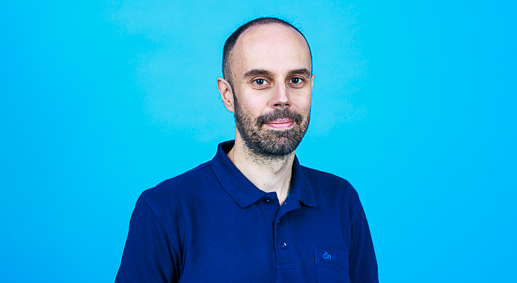Biosketch

Prof. dr. Andreas Milias-Argeitis
Andreas Milias-Argeitis studied electrical engineering with a focus on systems theory and automatic control at the University of Patras, Greece. He entered biology during his PhD at the Automatic Control Laboratory of ETH Zurich, where he worked on computational methods for inference, analysis and simulation of biochemical networks. Following his graduation in 2013, he joined the ETH Department of Biosystems Science and Engineering for his postdoctoral research, where he developed experimental and computational platforms for feedback control of gene expression and cell growth using optogenetics. Andreas his work provided one of the first applications of sophisticated control and estimation techniques for regulating cellular processes in real time.
In 2016 he obtained a tenure-track assistant professor position at GBB. Since then, a key goal of his research has been to understand the role of signaling pathways in the maintenance of cellular homeostasis under constant environmental conditions. To this end, his group studies the responses of signaling pathways to internal signals generated by other intracellular processes (e.g., the cell division cycle and biosynthetic processes), and the feedback signals that signaling pathways receive from their downstream effectors. At the experimental level, the group focuses on the development of optogenetic constructs for targeted, fast and reversible perturbations of intracellular networks, and on the creation of single-cell readouts to dynamically monitor the cellular state in response to these perturbations. Single-cell data are used to learn dynamic mixed-effects models that describe the behavior of a system of interest across a heterogeneous cell population. To facilitate this process, Andreas and his group also work on the development of machine learning and statistical methods for the automated analysis of dynamic single-cell microscopy data.
Three top publications 2017-2022
1. Guerra P, Vuillemenot LAP, van Oppen YB, Been M & Milias-Argeitis A (2022) TORC1 and PKA activity towards ribosome biogenesis oscillates in synchrony with the budding yeast cell cycle. Journal of Cell Science 135(18): 260378; DOI: https://doi.org/10.1242/jcs.260378.
For the first time in any eukaryotic organism, we showed that the activity of signaling pathways that control cell growth is dynamic during the cell cycle. Nutrient-sensing mechanisms upstream these pathways are involved in the regulation of their cell cycle dynamics, suggesting that these pathways respond to oscillatory internal metabolic signals during the cell cycle.
2. Litsios A, Huberts DH, Terpstra HM, ….., Exterkate M, Milias-Argeitis A* & Heinemann M* (2019) Differential scaling between G1 protein production and cell size dynamics promotes commitment to the cell division cycle in budding yeast. Nature Cell Biology 21(11); 1382-1392; DOI: https://doi.org/10.1038/s41556-019-0413-3.
Here, we showed that dynamics of protein production and cell size are decoupled during G1, leading to increased levels of Cln3 to trigger Start. With this work, we solved the long-standing enigma on how eukaryotic cells commit to a new round of cell division.
3. Rullan M, Benzinger D, Schmidt GW, Milias-Argeitis A* & Khammash M* (2018) An optogenetic platform for real-time, single-cell interrogation of stochastic transcriptional regulation. Molecular Cell 70(4): 745-756; DOI: https://doi.org/10.1016/j.molcel.2018.04.012.
In this work, we presented an experimental setup for the precise spatiotemporal delivery of light inputs to optogenetic constructs in living cells. By combining a fast-acting, light-sensitive transcription factor with nascent RNA quantification, we regulated transcription initiation via light-driven feedback loops in order to study various dynamic aspects of transcriptional regulation at the single-cell level.
